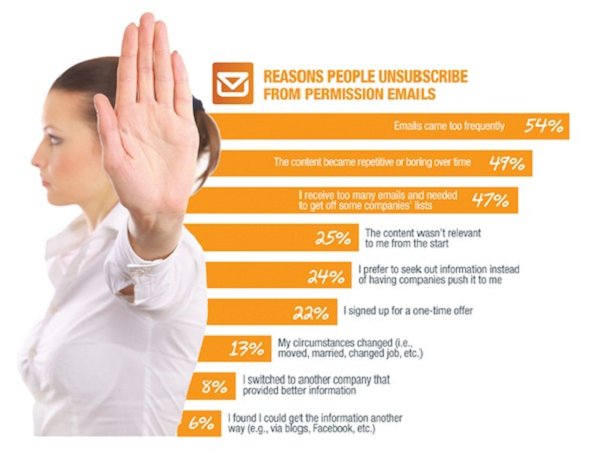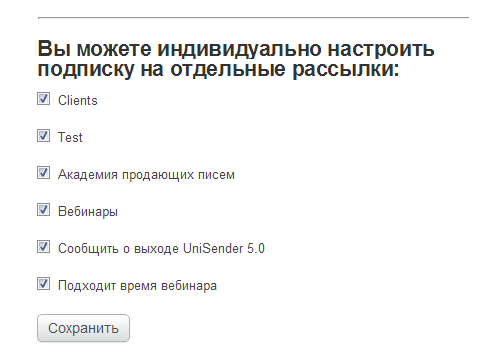Why followers are leaving you
Do you know why your newsletter subscribers stopped reading you? Then in this habratopic we’ll talk about what to do to keep your letters read and not even think about the unsubscribe button.

At KDPV, infographics that everyone knows tells us why people unsubscribe from letters they agreed to receive.
There are a few words before we start discussing ways to avoid unsubscribing:
- We are talking about letters that people agreed to (subscription, checkmark when placing an order, and the like). If you send letters without permission, then people unsubscribe because they hate spam.
- Someone else's research is good, but you can only find your own rake in your statistics. Therefore, do not forget that after the unsubscribe link there is also life, that is, the unsubscribe page.
On this page you can always gently ask what happened. Let the infographic be a clue what to ask. - 3. In the article we will talk about how to prevent such a turn of events. If a person has already unsubscribed, and you start to disturb him and find out why, he will click on the “This is spam” button.
So let's get started:
Letters come too often
This is one of the myths of email marketing. The fact that the frequency affects the attitude to the newsletter.
Shopping clubs send 5 letters a day and earn money. There are companies that send one letter in 3 months, but get a wave of negativity, because the New Year - everyone sends :).
It's all about the information and its presentation.
They endure useless information , but wait for useful information. How many letters a day would you like to receive with tips on how to make your work better and easier? And how much about the sale of compact combines in Makhachkala?
In the same way, your subscribers at the first glance at the letter determine what is interesting and what is the harvester. And they click on the unsubscribe or "This is spam."
What do we have to do:
- Maximum segmentation - divide your subscribers into groups and send letters that are interesting to this particular group. Feel free to write to the person in which group he is:
- For the online store “ I am writing to you because you bought an iPhone from us, and here are some useful iPhone applications you need .”
- For the training center “ You listened to the training * mega-celebrities * about the organization of working time. Now comes * another mega-celebrity * with the course "How to get to work not only myself, but also subordinates" ... "
- For tourism:" Last summer you flew with us to Delhi, this summer again to India? " - Do not repeat the content (more on that in the next paragraph).
- Link letters with history . If a person receives several letters with one “plot”, then this is already perceived as a kind of series. It’s quite difficult to do, but UniSender recommends doing the shares in series (the last example of the action with 8 letters showed that the increase in the number of unsubscriptions is too small compared to the increase in income).
- Check automatic emails . You set up automatic letters from CRM - well done. Then you open the history of sending to a person and you see that he received 6 different letters from you today. Trouble and sorrow.
- Suggest choosing a regularity :
- At a certain stage of “communication”. For example, after 4 letters, or 3 unread. Or if a person did not order anything, but did not unsubscribe.
- During the unsubscribe. Offer to choose the regularity of letters. For example, daily letters are not suitable for a person - “ do you want a weekly digest? "Or" with vodka per month . "
Content repeats over time or becomes boring
There are special cases when a client sends out the same letter every 15 days. What would you do if you received such letters?
Often, mailing companies do not really “diversify” their content. This is especially evident in online stores that send promotions. Yes, they sometimes make a different “festive” design, but that’s all.
The person already knows what you sent him. If you simply remind yourself of yourself in letters and hope that a person will remember you when the time comes, then you are probably a marketer of a very large hypermarket.
What do we do:
- We never send the same letter to the same person. If you do not know what to write, welcome to the Academy of Selling Letters .
- Mix:
- Useful content and marketing (4 to 1).
- Different forms of content - article, infographic, brochure, video, review in various forms, sale and promotion of one product, sale, thematic sale. You can add seals if the audience allows.
- Text letters and letters with pictures. - We occasionally give out something valuable. Information businessmen write letters “ My coolest training with a 90% discount one hour ”, an online store can offer, for example, a film, a cover, etc. a guarantee, but only today. Also do not forget about contests.
The point is to show - in the newsletter there is a “movement” and advantageous offers.
I get too many letters and want to unsubscribe from some companies
Translation into ordinary language: "I do not need your information." Here either paragraph 1 or the next paragraph.
Information is uninteresting from the very beginning
Here we sit down and think hard.
If a person from the very beginning agreed to receive information from us, but it didn’t “impress” him, that means he signed up for one offer or you didn’t guess with the segment.
What do we do:
- We are looking for a letter that creates unsubscribes. Such also happens. We look at the statistics, which caused a surge in negativity.
- We communicate with our audience. Perhaps you represent your client as a 23-year-old hipster from Moscow, who lives off his parents, but in fact he is a 34-year-old businessman from St. Petersburg, who has two children and a programmer wife.
Depending on the information received, we segment and modify the newsletter offers. Selling everything and everyone is much harder than a specific audience.
I prefer to search for information on my own. I don't want companies to remind me of anything
The problem is that a person can find this information from you, but in a different place. For example, on the site. That is, you yourself destroy the value of your newsletter.
So do online stores in their promotions - you can go to the site and find the promotion that is offered in the newsletter. With the same discounts and conditions. And now the question for connoisseurs: “ Why read the newsletter, which is not new? ".
A person sees a letter, thinks “Another Letter with Shares” and does not open it. The option is only suitable for those who are waiting by the river, while the current will bring them a client.
What do we do:
- Create the value of the newsletter - the newsletter should always have something that cannot be obtained otherwise. For example, a promotional code for a discount comes just by mail.
Or in the letter itself there is information that is not repeated on the site. Some information businessmen do this - articles in letters, and links to courses and trainings. - We give a choice which messages to receive. We do this:
- In the form of a subscription.
- In the form of unsubscribing via segmentation or different lists. For example, if a person receives promotions and your newsletter, then he can unsubscribe from some lists - the main thing is to correctly formulate.
For example, the author of this article now looks like the unsubscribe from UniSender mailings .

I signed up to receive what was offered for the subscription (one-time offer)
It happens. You promised a book (brochure, whitepaper), got a lead and decided to start sending these people your company news or photos of your cat.
What do we do:
- We offer what will help to segment . The white book “10 techniques of world-famous copywriters” draws you to everyone who knows the word copywriter, and the white book “How to write headlines for an automatic series in an e-mail newsletter” gives you advanced level e-mail marketers.
- If "caught for free" , then we promise that the freebie will continue in the letters. Periodically we give a freebie. This is the specificity of the audience that buys for shares - they will run to where it is cheaper, but they can cause a surge in sales as soon as they see the% icon.
- We write a welcome letter (sent immediately after the subscription), in which we detail what will happen in the newsletter, when and what the person receives. Do not drag out with this.
I have everything changed
You need to come to terms. If you are in Kiev, and the person moved to Cheboksary, then nothing can be changed. Or married, which sometimes equates to moving.
On the other hand, people often hide under this that the information is not interesting. We return to point 1 and remember that people lie. You also have to put up with this.
I read another company's newsletter
If translated literally - I use the services of another company that provides the best information. Infographics clearly refers to the infobusiness.
If many of your customers say that your competitor has better newsletter, then we begin to analyze.
What to do:
Two options:
- “Pull up” your newsletter to a competitor level (hire a good copywriter, do segmentation and automation, add design);
- To do what your competitor does not do (re-profile the newsletter, more unique offers).
I found out that I can not get information from the newsletter (blog, facebook and so on. Further)
What is the difference between this option and the "independent" reader? The latter does not want you to write to him, he experiences some negative feelings for you and yours remind you. It may be predisposed that e-mail is definitely spam.
In our case (if this is not a polite refusal), it is inconvenient for a person to receive letters.
We do everything the same as in the paragraph with an independent reader. In addition, we add on the website and in the letter template links to how you can receive your information in another way.
